Pierre Boulat
-
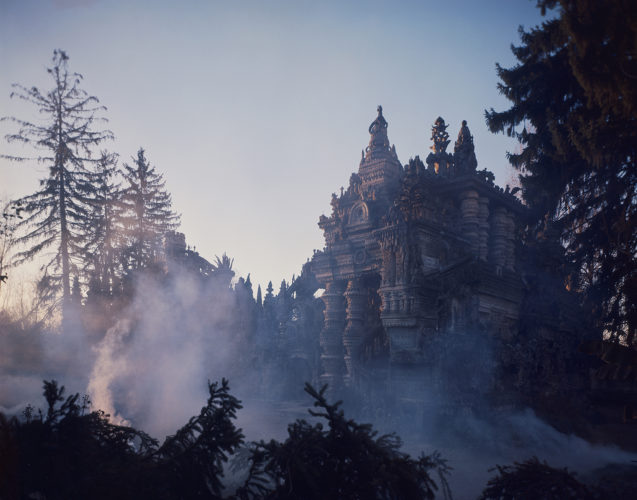
Naive Art - The ideal Palace of Postman Cheval
-
Ferdinand Cheval, a postman in the village of Hautes Rives in the Drôme, had only one dream: leave behind him a monument that would guarantee him nothing less than immortality. At 43 years old, his foot having, during his tour, struck a stone worked by the waters, he undertook to erect his Ideal Palace, sheltered behind the high walls of his garden. For 33 years, using a trowel, a few containers to mix his raw materials and his faithful wheelbarrow, Ferdinand Cheval will devote himself to the task of builder that he has set for himself. To carry it out, three thousand five hundred bags of cement and a few hundred cubic meters of stones which he picks up in the countryside at random during his tours. The entire surface of this Ideal Palace is covered with sculptures that represent the diversity of animal, plant and mineral life, the great periods in the history of cultures. As one walks through the building, climbs the spiral staircases, enters the tunnels and caves, one realizes that this aging man, working in the greatest solitude, has created with his hands a phantasmagorical world and the whole, although small at first glance, takes on heroic proportions. The monument is now classified as a National Monument. The East facade of the Ideal Palace of the Postman Cheval.. Between the two large blocks, the first stage of construction, a fountain that he saw as the source of his strength and genius. -
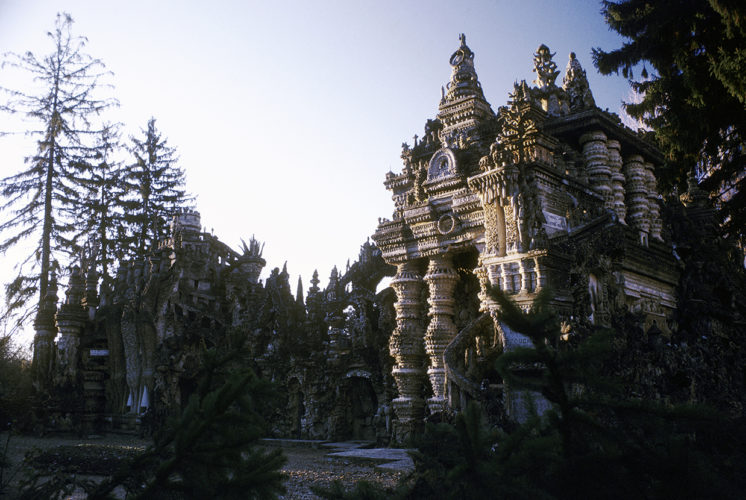
Naive Art - The ideal Palace of Postman Cheval
-
The East facade of the Ideal Palace of the Postman Cheval.. Between the two large blocks, the first stage of construction, a fountain that he saw as the source of his strength and genius. -
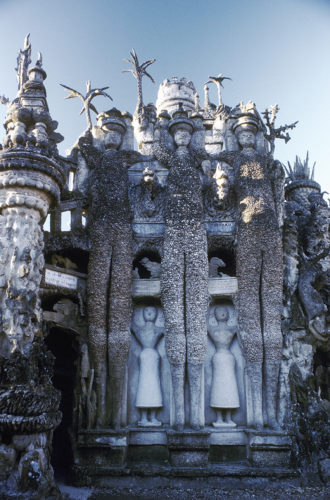
Naive Art - The ideal Palace of Postman Cheval
-
On the eastern façade of the Ideal Palace of the Postman Cheval are three giants in stone and shells representing Vercingetorix, Archimedes and Caesar. The two smaller figures are two druidsesses whom he called Veleda and Inize. -
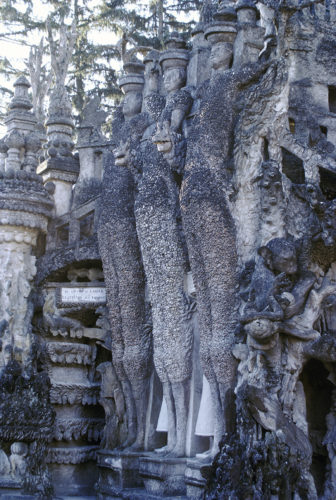
Naive Art - The ideal Palace of Postman Cheval
-
The eastern façade of the Ideal Palace of the Postman Cheval with its three giants in stone and shells representing Vercingetorix, Archimedes and Caesar. All around are caves, spires, towers and other gargoyles. -
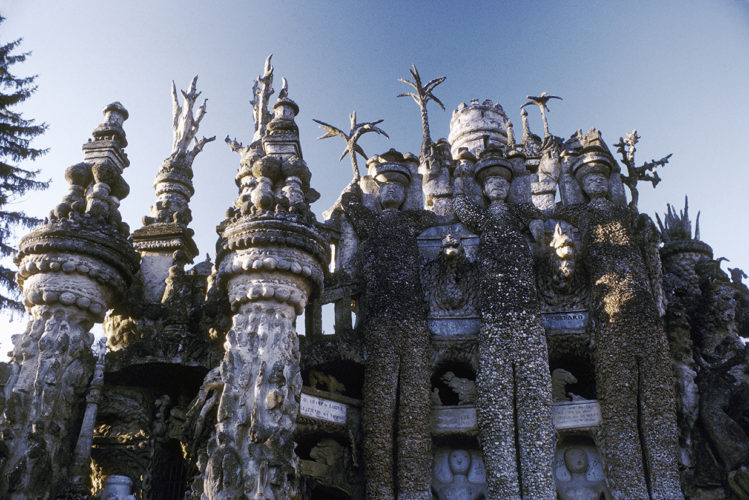
Naive Art - The ideal Palace of Postman Cheval
-
The eastern façade of the Ideal Palace of the Postman Cheval with its three giants in stone and shells representing Vercingetorix, Archimedes and Caesar. All around are caves, spires, towers and other gargoyles. -
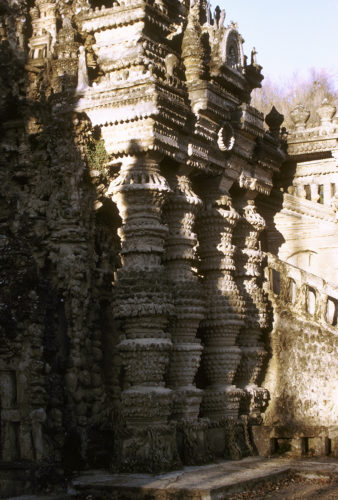
Naive Art - The ideal Palace of Postman Cheval
-
Behind these four columns on the eastern façade of the Ideal Palace, the entrance to the tomb in which the Postman Cheval would have liked to be buried, in the manner of the Pharaohs. -
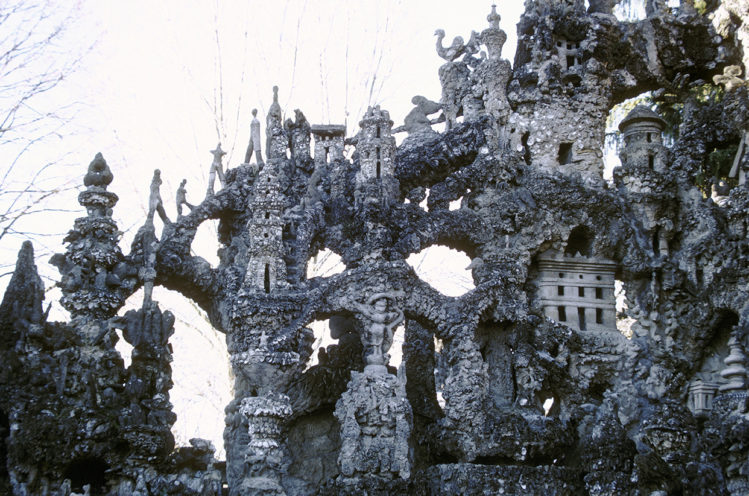
Naive Art - The ideal Palace of Postman Cheval
-
Tangle of sculptures, arrows and gargoyles on the roof of the Palace of the Postman Cheval. -
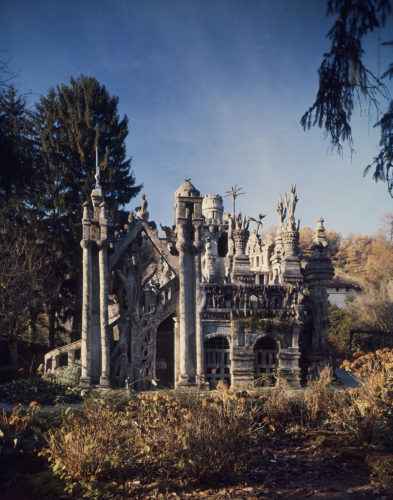
Naive Art - The ideal Palace of Postman Cheval
-
West facade of the Ideal Palace of the Postman Cheval. -
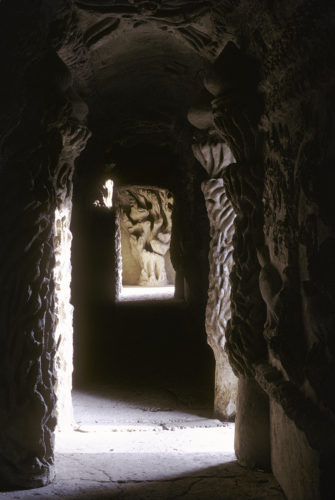
Naive Art - The ideal Palace of Postman Cheval
-
Corridor inside the Ideal Palace of the Postman Cheval. -
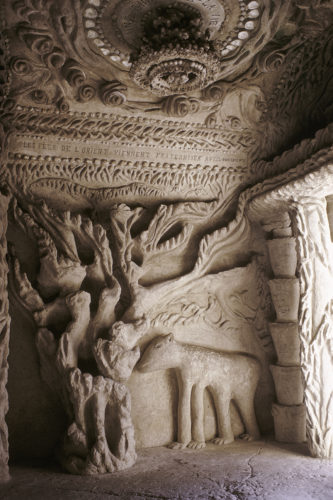
Naive Art - The ideal Palace of Postman Cheval
-
All kinds of animal sculptures populate the interior of the Ideal Palace of the Postman Cheval -
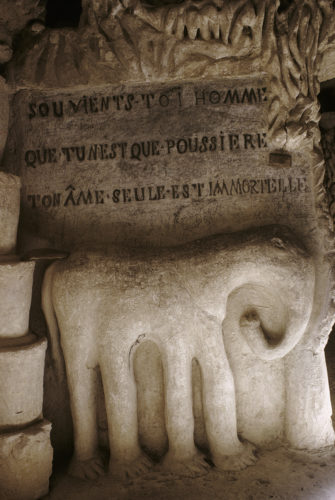
Naive Art - The ideal Palace of Postman Cheval
-
Postman Cheval sowed here and there in his palace some well thought-out maxims. -
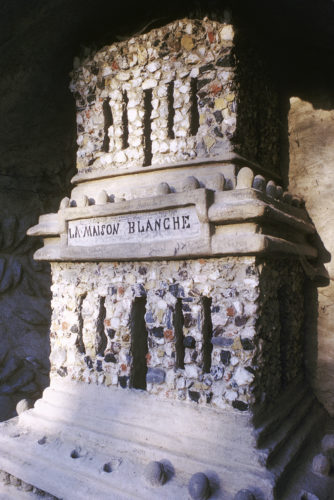
Naive Art - The ideal Palace of Postman Cheval
-
The "White House" - one of the many stone and cement sculptures that decorate the interior of the Ideal Palace of Postman Cheval and which represent temples or palaces. -
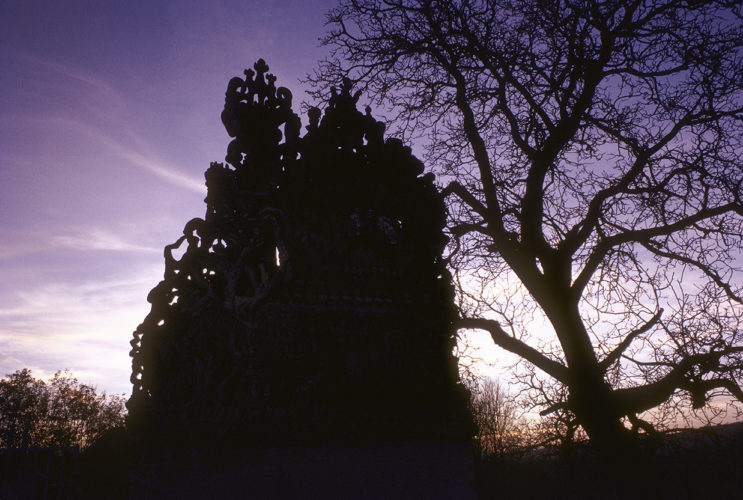
Naive Art - The ideal Palace of Postman Cheval
-
The tomb of the postman Cheval in the Hautes Rives cemetery. Having been unable to obtain permission to be buried in his palace, he spent the last 10 years of his life building this tomb made of cement filaments. -
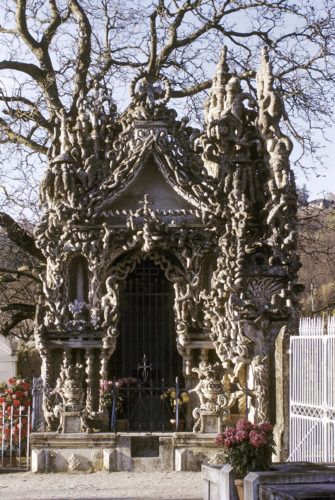
Naive Art - The ideal Palace of Postman Cheval
-
The tomb of the postman Cheval in the Hautes Rives cemetery. Having been unable to obtain permission to be buried in his palace, he spent the last 10 years of his life building this tomb made of cement filaments. -
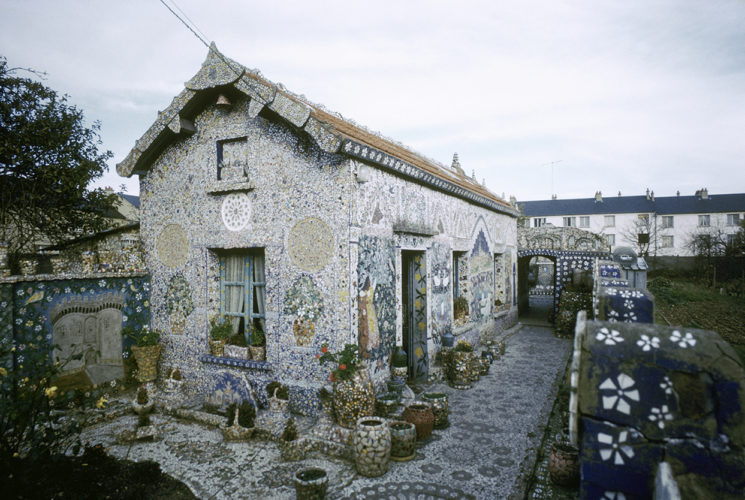
Naive Art - Raymond Isidore's house "Pique-assiette"
-
Isidore's mosaic work alone is a monument, in the same vein as the work of the Postman Cheval. A sweeper at the Chartres cemetery, Raymond Isidore, who had never even gone as far away as Paris, spent 33 years of his life building and decorating his pavilion and the garden that surrounds it. His ambitions were less excessive than those of the Horse Postman, but he put just as much perseverance into it. Every day, after work, he threw a bag over his shoulders, rode his bicycle and roamed the surrounding rubbish dumps looking for broken plates - hence his nickname "Pique Assiette". Although he is less imaginative than the Horse Postman, his hand, on the other hand, shows rare qualities as an illustrator. And above all, he splashed everything with the only thing that the Horse Postman lacked: colour.Today, surrounded by grey and sad buildings, the "Maison Pique Assiette" looks like a jewel in a hand full of pebbles. The house, which now belongs to the Museum of Fine Arts of the city of Chartres, was classified as a historical monument in 1983. Raymond Isidore's house and garden are entirely covered with mosaics made with broken plates. -
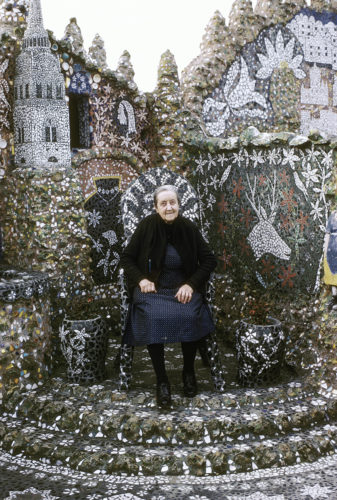
Naive Art - Raymond Isidore's house "Pique-assiette"
-
The widow of Raymond Isidore sitting on the throne in the garden of the house. -
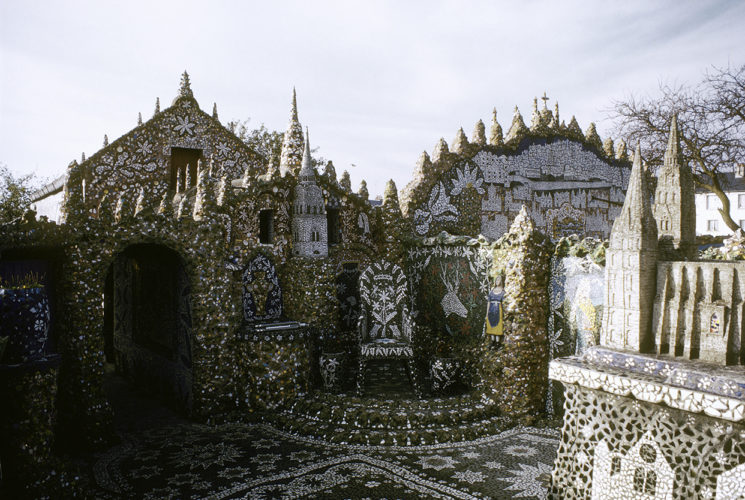
Naive Art - Raymond Isidore's house "Pique-assiette"
-
Raymond Isidore's house and garden are entirely covered with mosaics made with broken plates. -
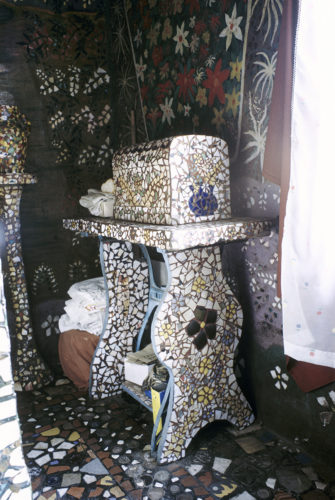
Naive Art - Raymond Isidore's house "Pique-assiette"
-
In Raymond Isidore's house, even the furniture is decorated with broken dishes. Here the sewing machine. -
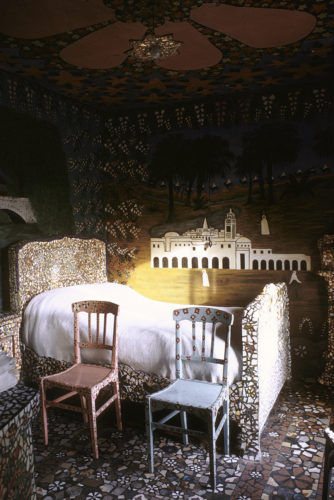
Naive Art - Raymond Isidore's house "Pique-assiette"
-
In Raymond Isidore's house, even the furniture is decorated with broken dishes. This is the bedroom. -
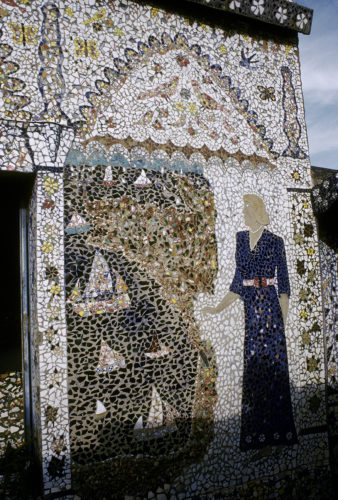
Naive Art - Raymond Isidore's house "Pique-assiette"
-
Raymond Isidore's house and garden are entirely covered with mosaics made with broken plates. -
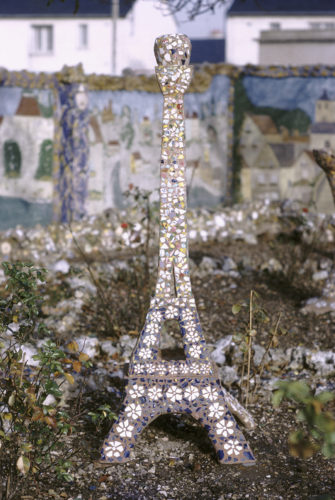
Naive Art - Raymond Isidore's house "Pique-assiette"
-
Eiffel Tower in broken plates in the garden of Raymond Isidore's house. -
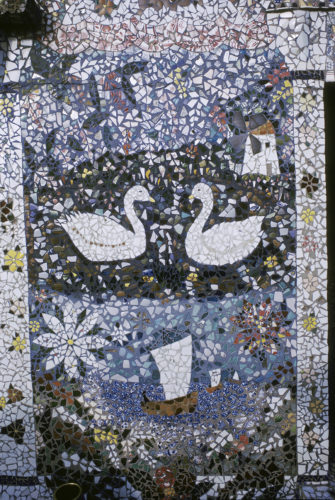
Naive Art - Raymond Isidore's house "Pique-assiette"
-
Country scene in mosaic on Raymond Isidore's house. -
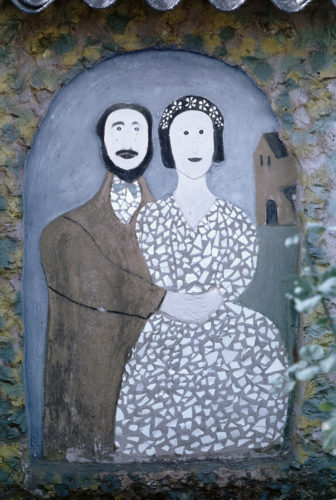
Naive Art - Raymond Isidore's house "Pique-assiette"
-
Couple in mosaic made of broken plates on the house of Raymond Isidore, representing Raymond Isidore and his wife on their wedding day. -
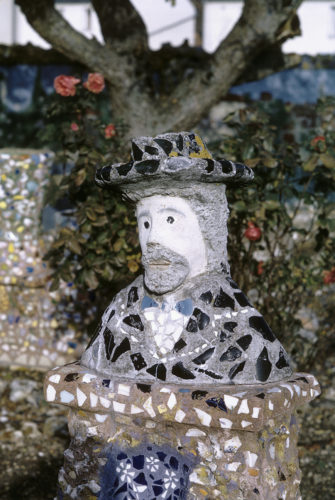
Naive Art - Raymond Isidore's house "Pique-assiette"
-
Imaginary character in mosaic in the garden of Raymond Isidore's house. -
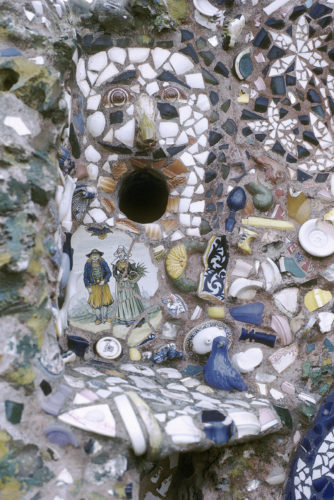
Naive Art - Raymond Isidore's house "Pique-assiette"
-
Imaginary character in mosaic in the garden of Raymond Isidore's house. -
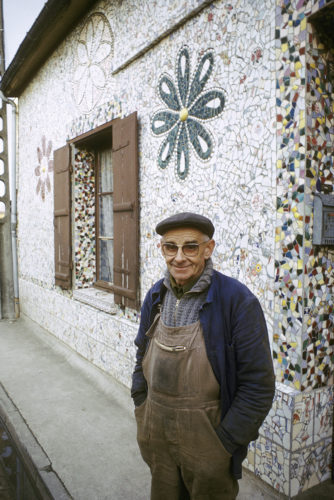
Naive Art - Robert Vasseur's house with borken dishes
-
It was the same spontaneity and the same desire to illuminate a dull environment that animated Robert Vasseur, a dairy truck driver in the small industrial town of Louviers in Normandy. Like Isidore, he uses pieces of plates and earthenware, but his preference is for shells, which he brings back from the nearby Normandy coast. When he heard about Isidore's house, he took his wife as far as Chartres to visit it, but he concluded "she's not as good as mine! ». Robert Vasseur in front of his house in Louviers, entirely decorated with broken plates and shells. -
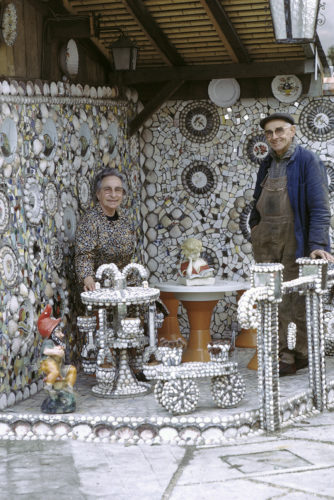
Naive Art - Robert Vasseur's house with borken dishes
-
Robert Vasseur in front of his house in Louviers, entirely decorated with broken plates and shells. -
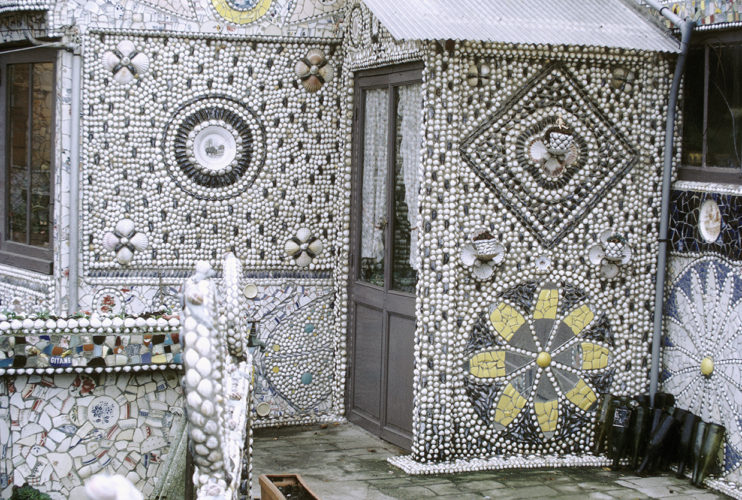
Naive Art - Robert Vasseur's house with borken dishes
-
Shell decoration of the walls of Robert Vasseur's house in Louviers. -
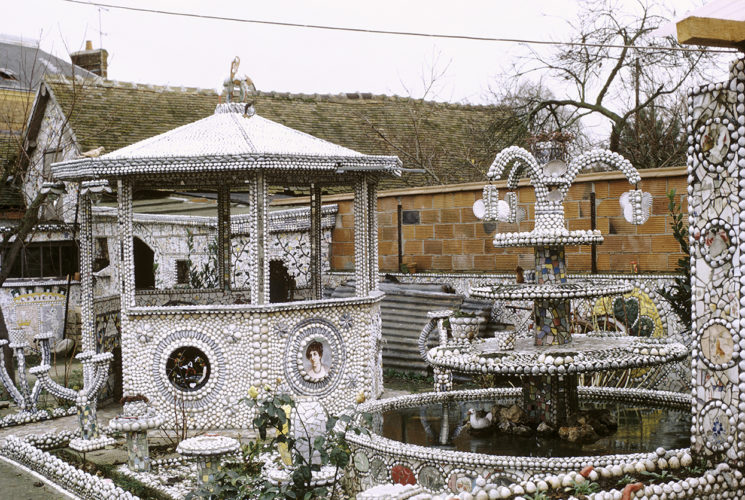
Naive Art - Robert Vasseur's house with borken dishes
-
The garden of Robert Vasseur's house in Louviers with its shell decorations. -
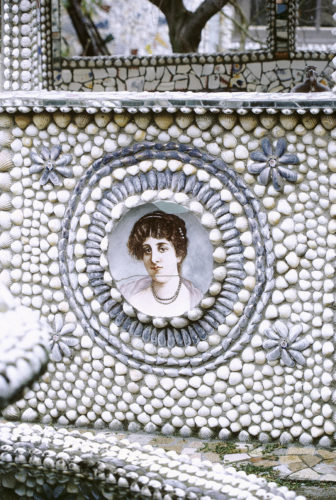
Naive Art - Robert Vasseur's house with borken dishes
-
Close-up of the shell decoration of the well in the garden of Robert Vasseur's house in Louviers. -
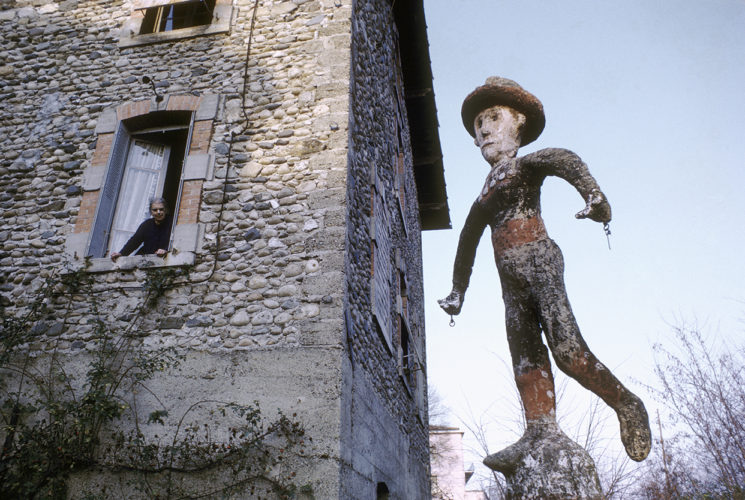
Naive Art - Alphonse Gurlhie's bestiarry
-
The sympathetic bestiary surrounding the house of Alphonse Gurlhie, a net maker who lived on the banks of the Rhone in the south of France, only proves his love for animals and that he chose to paint them in a most familiar way: a bear playing the violin or a big flatfish leaping from the top of a perch. His sculptures are now grouped together in a "Garden of Raw Art". The house of Augustus Gulhie with his widow at the window and a sculpture probably depicting him himself. -
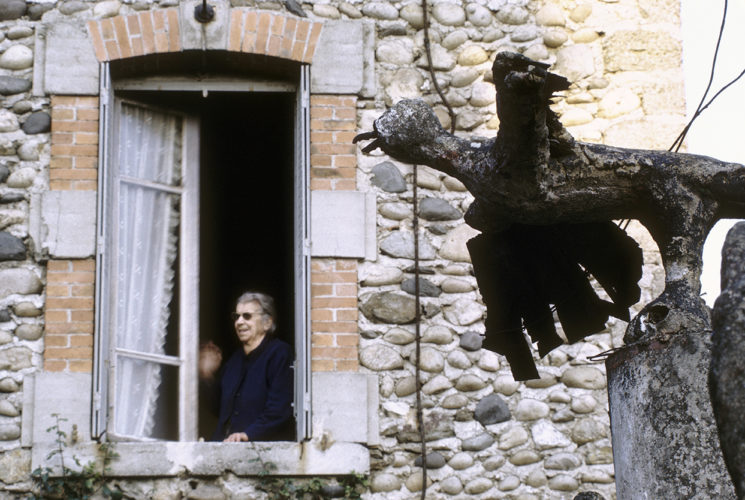
Naive Art - Alphonse Gurlhie's bestiarry
-
Bird from Alfonse Gulhie's bestiary in front of his house. With his widow at the window -
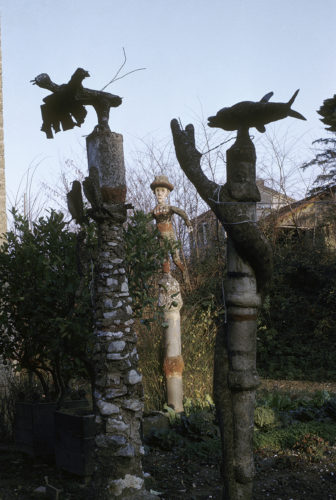
Naive Art - Alphonse Gurlhie's bestiarry
-
In the garden of Alfonse Gulhie's house, two animals from his bestiary, a bird and a big flatfish at the top of a perch. Behind, a man probably representing Alphonse Gulgie himself. -
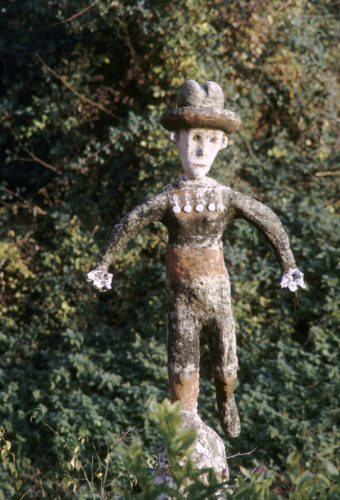
Naive Art - Alphonse Gurlhie's bestiarry
-
Close-up of the man. -
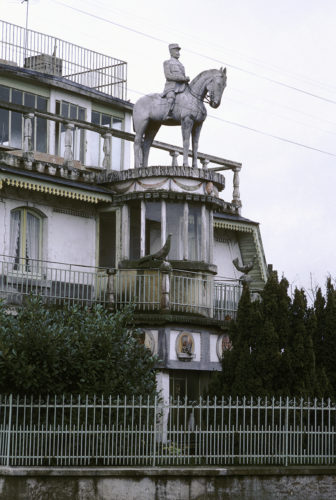
Naive Art - Alphonse Wallart's house
-
Alphonse Wallart, who lived near Armentières, was so proud that France emerged as a heroine of the First World War that he decorated his house with a monumental statue of General Foch. He then exposed his political tendencies by sculpting a statue of General De Gaulle in concrete. Unfortunately his wife was not a Gaullist. When Alfonso died she dismantled de Gaulle which stood on the roof and donated it to the local bistro. Delighted, the owner installed the statue in the middle of his lettuce patch. The statue of General Foch on the house of Alphonse Wallart near Armentières. -
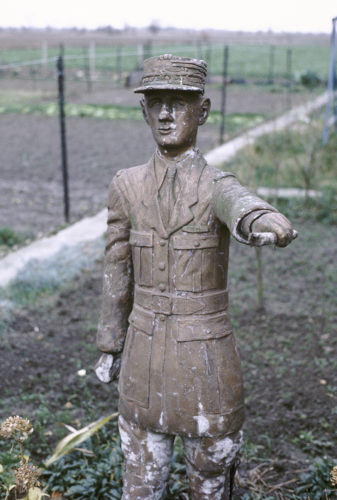
Naive Art - Alphonse Wallart's house
-
The statue of General de Gaulle in the vegetable garden of the owner of the bistro to whom the widow of Alphonse Wallart had given it on the death of her husband. -
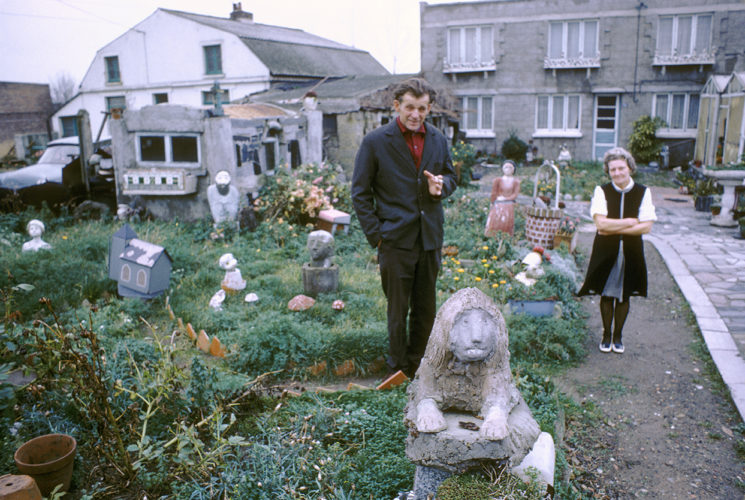
Naive Art - Victor Lemaire's house
-
Victor Lemaire, a miner in the mining region of Béthune, may have wanted to be a little different from the others by building a mailbox in polychrome marble, but in the end it is pure Pop Art. Victor Lemaire and his wife in the garden of the house with some of his sculptures. -
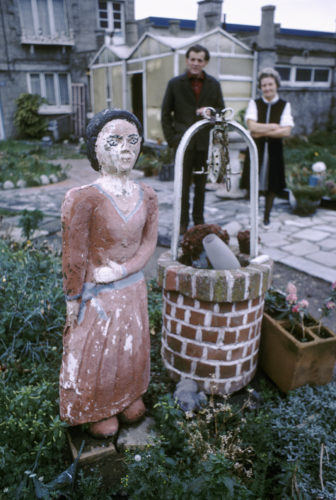
Naive Art - Victor Lemaire's house
-
Sculptures by Victor Lemaire, a woman and a cement well. -
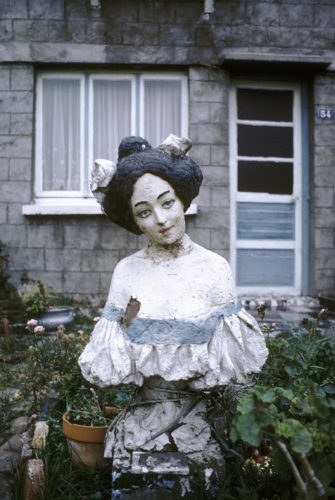
Naive Art - Victor Lemaire's house
-
Victor Lemaire's cement Japanese in the garden of his house. -
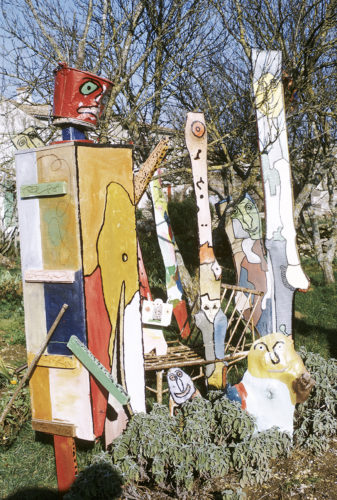
Naive Art - Gaston Chaissac's totems
-
Gaston Chaissac was a shoemaker who lived in the small hamlet of Vix, near the Atlantic coast. Chaissac was always having fun smearing paint and occasionally used old wood waste that had been strangely shaped and salvaged from the village sawmill to make brightly coloured totem poles. He had been doing this for many years already, when someone showed him reproductions of Dubuffet and Picasso's works. He recognized them immediately - it was what he had been doing all along. Chaissac's talent is now recognised and his totems are classified as "Art Brut" - The Musée des Arts Décoratifs de Paris devoted an exhibition to him in 1973. The totems of Gaston Chaissac who lived in the small hamlet of Vix in the Vendée... He painted them on pieces of wood salvaged from the nearby sawmill. -
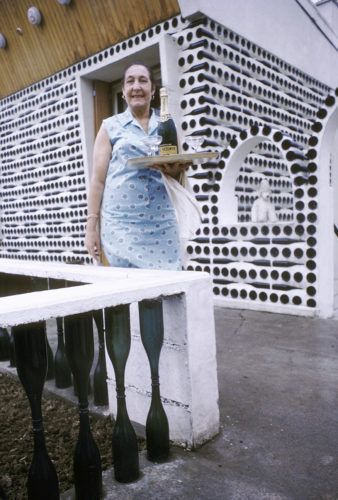
Naive Art - Charles Dufrenne's house
-
Dufrenne, a mason from father to son, built his house at Aulnay la Rivière in the south of Paris with 15,000 bottles of champagne and hoped to make it his retirement home. When he died, his wife turned it into a bar. A bowling alley in a corner of the garden is probably a representation of himself. Like any good Frenchman, he was a fanatic of the game. Charles Dufrenne's house in Aulnay la Rivière south of Paris made from 15,000 bottles of champagne and turned into a bar by his widow. Today it is once again a private house.
Naive Art
André Malraux said of naive art that it is “a banal phenomenon known to all… what is called naive art is today what touches the general public most deeply…”
France seems particularly rich in naïve artists. Starting with the very famous Facteur Cheval who devoted his life to building a palace of heroic proportions. The Ideal Palace has long been classified as a Historic Monument, just like some other houses that gentle dreamers have transformed over the course of their lives, using recycled materials.
What is most striking about most of these naïve artists is that they belong to their time, something that reveals itself despite their isolation. They knew nothing of the other builders. The very essence of naive art is precisely that each one finds in his or her own head a completely original and improvised expression.


